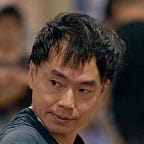Art Review: Haboku Project
“Writing and drawing is an act of dance. And it’s a beautiful one.”
This message came up in my mind after I watched an hour-long art performance of the Haboku Project, an initiative by a group of artists in Kobe, Japan, to reconstruct the 8th-century Chinese avant-garde art of ink painting known as haboku (破墨) or “broken ink”.
The message itself may not be new. But the way of its delivery was beyond my expectation: a Japanese religious dance that dates back to one thousand years ago.
The performance starts with the hanging of a large piece of blue-and-white striped cloth from the ceiling, followed by a solo dance of Kagura, a religious theatrical dance of Japan that was established around the year of AD 1000.
As the dance quietly goes on, two artists walk around the square stage and stop to perform some drawing and writing on pieces of paper, and also on the hanging cloth. They seem to be drawing the dancer and the stage set, although the audience cannot clearly see what they are drawing.
The Kagura dance continues. Through the half-opened door at the back of the stage, the afternoon sunlight casts the backlight over the dancer’s silhouette. The dancer’s hand movement starts looking like the act of three-dimensional drawing in the air.
At this point, I wondered if this performance aimed to let us see drawing and writing as an act of dancing. The final results of drawing and writing were not considered important here. It was the body movement of drawers and writers that counted.
But there was more…
The striped piece of cloth falls on the stage and then, with more drawing and writing added, gets spread and hung from the ceiling again. Illuminated from the back with the sunlight through the back door, the piece of cloth becomes a canvas waiting for the last strokes of brushes to be filled in.
The dancer, exiting from the stage once, reenters the scene with two leafy twigs. In ancient Japan, people believed that tree shoots would house divinities. In this art performance, they resembled brushes to draw or pens to write.
While a series of choreography is going on with the twigs, the two artists bring in to the stage three buckets of coloured ink and then place them in the middle of the stage as if they were the sacred water as an offering.
The dancer then stands in front of each bucket, one by one, pierces the twigs into the bucket, and splashes the ink against the hanging cloth. The splashing sound is rhythmical enough to evoke the sense of some kind of a religious ceremony. In this ritual, dancing transforms back into drawing.
After the dancer leaves the stage, a piece of abstract painting emerges in front of us the audience, illuminated with the backlight of the sunshine.
I found it beautiful. It made me see the act of ink painting as a beautiful form of dance. And the beauty struck a chord with me deeply thanks to the form of dance deeply rooted in the tradition.
That was unexpected. Traditional art is usually either conducted for the sake of its preservation, or fused into modern entertainment – often in a superficial way. Here in this art performance, traditional art serves as a medium of contemporary art to cast a new light on the act of drawing.
I couldn’t move for a while after the performance was over…
After I managed to compose myself, I talked to one of the performing artists. Our conversation made me learn that the term “ink” in the phrase of “broken ink” symbolises what people take for granted, often subconsciously, such as stereotypes and kleshas in Buddhism. For the 8th-century Chinese intellectuals, ink must have been part of their daily life, something they had no doubt about. By “breaking” it, we will discover something new.
Today’s art performance is not the only one from the Haboku Project. The artists have already conducted several performances in the past. Each performance “breaks ink” to reveal something unexpected. Taken together, these performances of the Haboku Project vividly express the concept of “broken ink” in the original 8th-century Chinese sense.
Background Information
The Haboku Project was initiated by Kazuya Yamashita, an ink painting artist best known for his award-winning work of drawing wind-blown leaves of pine trees with very subtle differences in the density of Chinese ink:
For his attempt to deepen our understanding of “broken ink”, one of the historical origins of Chinese and Japanese ink paintings, Yamashita is joined by Miho Takayasu, an actor who was trained as a Kagura dancer during her childhood, Misaki Shibayama, an artist who not only works with drawings and paintings but also with writing, and Yoshiyuki Sumino, a fashion designer of his own brand Thee Trio.
The cross-genre collaboration is a deliberate choice: the original “broken ink” in the 8th-century China was also an interdisciplinary work of artists at that time.
The video recordings of past performances are available on the Haboku project’s YouTube channel, where you’ll see what Kagura dance looks like.
Once the video of today’s performance is uploaded, I’ll put a link to it on this article.
Update (18 Oct, 2020): Now the performance video is available:
